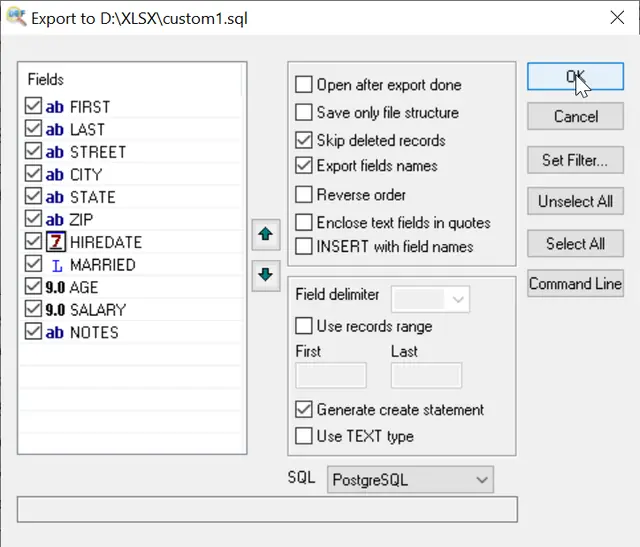Export DBF to PostgreSQL
DBF files have long been one of the most popular formats for storing structured data, especially among legacy systems and accounting software. However, modern projects often require integrating this data into more powerful and scalable solutions, such as PostgreSQL.
This article takes a detailed look at the process of migrating data from DBF to PostgreSQL using DBF Viewer 2000, a handy tool for working with DBF files.
Why Export DBF to PostgreSQL?
DBF (DataBase File) is used in many accounting, warehouse and business applications. This format allows you to easily work with tables and store structured data. However, as the volume of information grows and the need for complex analytics increases, it becomes necessary to move the data to a modern DBMS. PostgreSQL is a powerful relational database with support for transactions, indexing and complex queries, making it an ideal option for storing and analyzing large data sets.
Exporting data from DBF to PostgreSQL allows you to:
- Combine old and new data - integration with current databases.
- Use complex queries and analytical tools - PostgreSQL supports SQL operators, functions, and triggers.
- Increase storage reliability - data is stored in a modern DBMS with the ability to back up and restore.
- Access information faster - indexing and query optimization in PostgreSQL allow you to work with large volumes of data faster than in old DBF tables.
Step-By-Step Instructions for Exporting to PostgreSQL
Step 1. Open the DBF file
Launch DBF Viewer 2000. In the program menu, select File → Open and find the desired DBF file.
Step 2: Creating an SQL script for PostgreSQL
After setting up, click Export and specify the location to save the SQL file and select options "PostgreSQL".

Step 3: Loading data to the PostgreSQL server
- Open a terminal or use a graphical PostgreSQL client, such as pgAdmin.
- Run the SQL script created in DBF Viewer 2000. For example, via the command line:
psql -U username -d database_name -f path_to_sql_file.sql
After executing the script, the data from the DBF file will appear in the PostgreSQL table.
DBF to PostgreSQL Exporting via Command Line
Simple Export to PostgreSQL format
Create Table without Records
Export with Columns Selection
Export with Columns Names
Advantages of using DBF Viewer 2000
DBF Viewer 2000 is a powerful tool that significantly simplifies working with DBF files and transferring data to PostgreSQL. Its graphical interface makes it easy to perform all necessary operations without any programming knowledge, while the program ensures full compatibility with various DBF versions, including dBase III, dBase IV, and Visual FoxPro.
The software offers flexible export options, allowing users to configure data types, encoding, and script format to prevent issues during import into PostgreSQL. Additionally, DBF Viewer 2000 offers a reliable workflow with minimal risk of data loss, thanks to features such as data preview and test export before final execution.
Do you need other options for PostgreSQL format generation?
Please, contact us by E-mail: support@dbf2002.com or by On-line form.
See also: DBF to XLS (Excel), DBF to CSV, Filtering records, Command line options